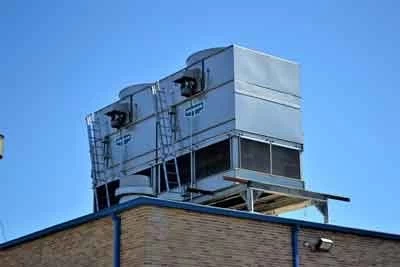How Building Automation-HVAC Integration Improves Indoor Air Quality

Traditionally, HVAC systems within the context of building automation have focused primarily on temperature control for occupant comfort. However, the growing awareness of the profound impact of indoor air quality (IAQ) on health, well-being, and cognitive performance is driving an increased emphasis on air quality management strategies. Building automation integrated with HVAC offers powerful tools to actively monitor, manage, and enhance the air we breathe indoors.
Visit Our Building Automation Study Course
The IAQ Factors HVAC Integration Can Address
Indoor air quality (IAQ) significantly impacts occupant health, comfort, and productivity. Building Automation Systems (BAS) can play a vital role in optimizing IAQ by integrating seamlessly with Heating, Ventilation, and Air Conditioning (HVAC) systems.
Carbon Dioxide (CO2): A key indicator of ventilation adequacy. High CO2 levels suggest insufficient fresh air is being mixed with recirculated air, leading to a buildup of contaminants and potential cognitive impairment for occupants.
Humidity: Both high and low humidity levels impact comfort and health. High humidity fosters mold growth, while very dry air can irritate respiratory systems. HVAC systems play a crucial role in maintaining humidity within suitable ranges.
Particulate Matter (PM): Fine dust particles (PM10 and PM2.5) originating from outdoors or generated inside the building can cause respiratory issues. HVAC systems with appropriate filtration are crucial for removing these particles.
Volatile Organic Compounds (VOCs): Off-gassing from building materials, cleaning products, and some equipment can release various VOCs. While harder to directly measure, increased ventilation or specialized air treatment help dilute and remove these compounds.
How Building Automation Enhances IAQ Management
Maintaining optimal indoor air quality (IAQ) is crucial for occupant well-being and productivity. Traditional HVAC systems often operate on a fixed schedule, potentially leading to inefficiencies and compromised air quality. Building Automation Systems (BAS) offer a powerful solution by integrating with HVAC systems and employing a range of advanced features to actively monitor, analyze, and optimize IAQ.
Sophisticated Sensor Networks: Beyond temperature, building automation systems can integrate CO2 sensors, humidity sensors, and, in certain cases, sensors capable of monitoring particulate matter levels. This data gives a real-time picture of IAQ.
Demand-Controlled Ventilation (DCV): Instead of ventilating at a fixed rate, the building automation system dynamically adjusts outdoor air intake based on measured CO2 levels. This avoids over-ventilation (wasting energy) while ensuring adequate fresh air when the building is occupied.
Integration with Filtration Systems: The building automation system can monitor pressure differential across filters, indicating their loading and triggering alerts for replacement. Some systems can even adjust fan speeds to compensate and maintain airflow as filters become dirtier.
Proactive Air Quality Management: Utilizing historical IAQ data and predictive analytics, a sophisticated automation system can identify patterns, anticipate periods of poor air quality, and preemptively increase ventilation or take other corrective measures.
System-level Integration: Automated HVAC control extends to linked systems like exhaust fans, specialized air purification equipment, or energy recovery ventilators (ERVs), ensuring that all components work in concert for maximum IAQ benefit.
IAQ Data Visualization: The building automation system can present detailed visualizations of air quality trends in different zones of the building. This aids in diagnosing problem areas and tracking the effectiveness of implemented IAQ improvement measures.
Beyond Just the Technology – Best Practices Matter
Building Automation Systems (BAS) offer a powerful tool for managing indoor air quality (IAQ). However, technology alone is not a magic bullet. To achieve optimal IAQ, a comprehensive approach integrating BAS functionalities with established best practices is essential. While technology plays a crucial role, truly optimizing IAQ requires a holistic approach:
Filter Selection: Choosing the right MERV-rated filters for a given HVAC system is vital to capture target contaminants without overly restricting airflow.
System Design and Maintenance: Well-designed air distribution and regular cleaning of ductwork are fundamental to preventing IAQ problems at the source.
Occupant Education: Communicating with occupants on ventilation strategies and empowering them to report comfort or air quality concerns improves the feedback loop within the management system.
Benefits of Automation-Enabled IAQ Management
Building Automation Systems (BAS) offer a compelling solution for optimizing indoor air quality (IAQ). Beyond the technical advantages, implementing BAS-enabled IAQ management unlocks a range of significant benefits for building occupants, owners, and operators.
Improved Occupant Health and Productivity: Studies link better IAQ with reduced respiratory issues, allergy symptoms, and improved cognitive function. This directly translates to less absenteeism and a more productive workspace.
Building Reputation and Attractiveness: Proactive IAQ management aligns with increased health consciousness in the workplace, making a building more attractive to tenants or employees.
Energy Efficiency, Not at Odds: Demand-controlled ventilation and strategic filter management can achieve better IAQ without necessarily sacrificing energy efficiency.
Compliance: Some jurisdictions mandate certain IAQ monitoring or standards, especially in schools and healthcare facilities. Automation assists in achieving and documenting compliance.
Building automation is graduating from a focus on temperature alone to become a powerful force in the quest for healthier indoor environments. By continuously analyzing IAQ metrics, intelligently adjusting ventilation, optimizing filtration, and offering actionable data analytics, the integration of building automation and HVAC allows for the creation of indoor spaces that are not only comfortable but actively promote the well-being of occupants.







